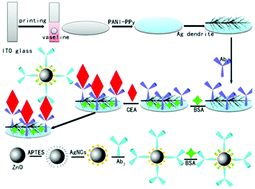Electrochemiluminescence behavior of AgNCs and its application in immunosensors based on PANI/PPy-Ag dendrite-modified electrode
Abstract
In this study, hyperbranched polyethyleneimine-protected silver nanoclusters (hPEI-AgNCs) with excellent electrochemiluminescence (ECL) emission in the presence of coreactant K2S2O8 were prepared by chemical reduction of silver ions (silver nitrate) coordinated with dendrigraft polymer, and successfully used for the construction of an ECL immunosensor. Polyaniline (PANI)/polypyrrole (PPy)-silver (Ag) dendrites with good electrical conductivity and biocompatibility were electropolymerized on the surface of indium tin oxide (ITO) electrode as carriers. Porous ZnO sphere-loaded hPEI-AgNCs-induced signal amplification strategies were integrated exquisitely and applied sufficiently. Taking carcinoembryonic antigen (CEA) as an example, under optimal conditions, the CEA concentration was determined to be in the range of 10−3 ng mL−1–100 ng mL−1 and with a detection limit of 0.4 pg mL−1 using this method; it exhibited excellent selectivity, high stability, and acceptable fabrication reproducibility. It was anticipated that hPEI-AgNCs would have promising applications in green, selective, and sensitive detection of target analytes in the future.



 Please wait while we load your content...
Please wait while we load your content...